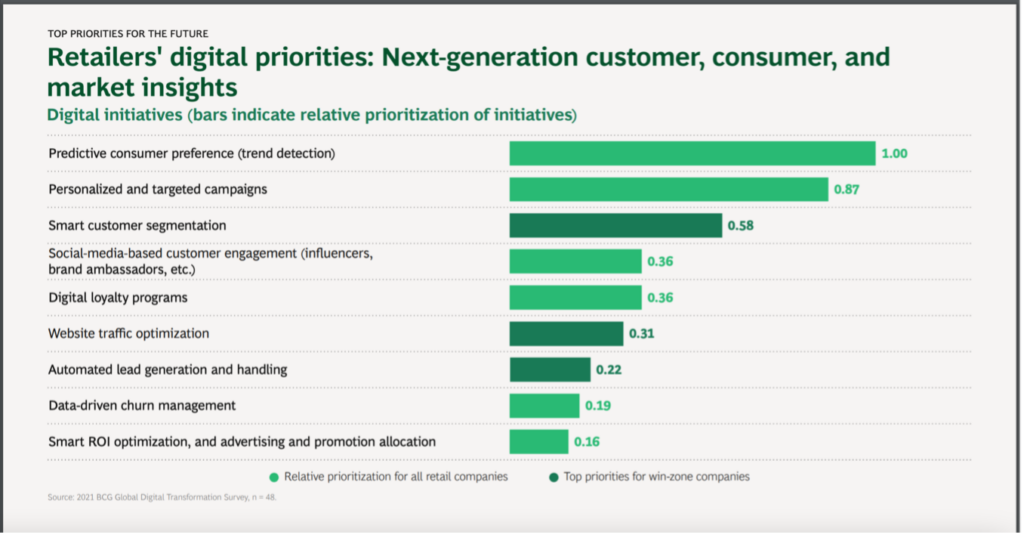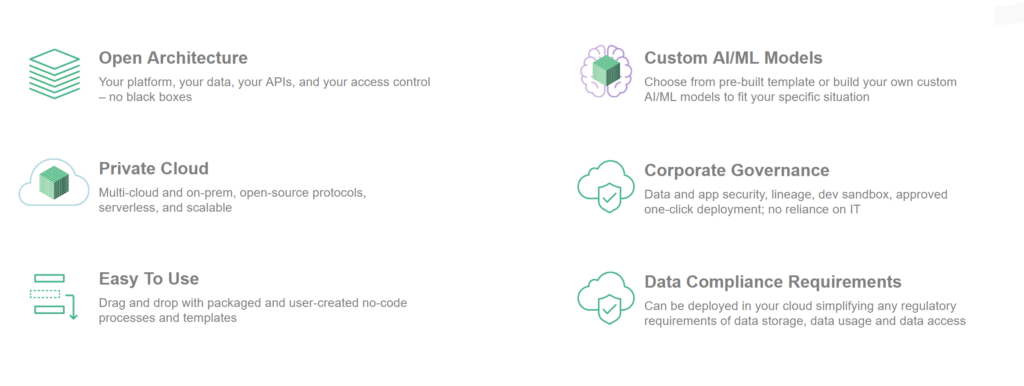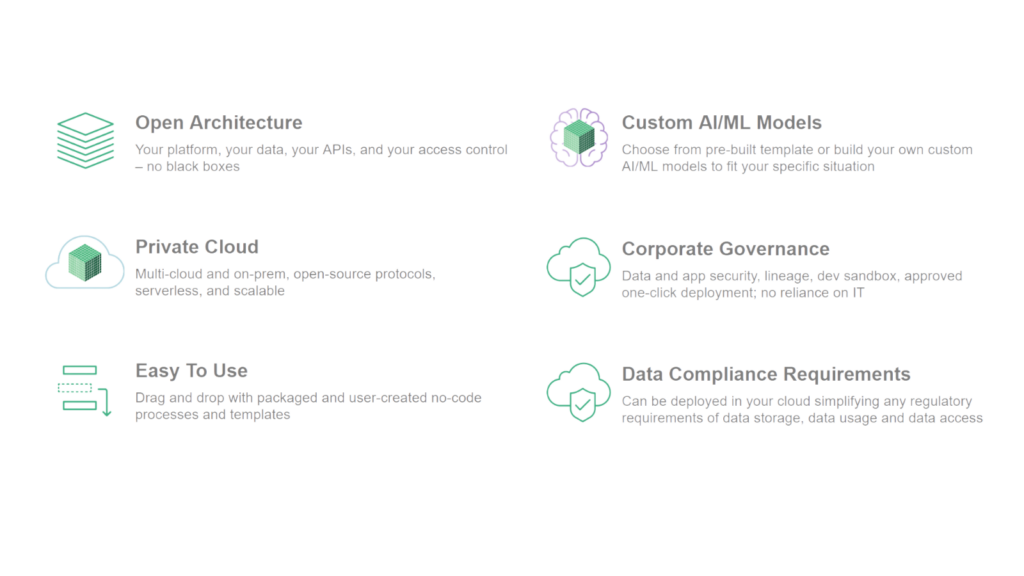Transformation leaders across industries are thinking about what customer data they need and how they can leverage this data to achieve their business goals: elevating the customer experience, increasing loyalty and retention, and growing their customer base and revenue.
Organisations are on a journey to unify all the customer data they hold, personalise the experience for their customers across channels, and measure sentiment and return on investment. Additionally, external factors in an ever-shifting landscape are pushing organisations to launch programmes focused on ‘marketing in a cookieless future’ and ‘privacy by design’.

A recent survey by BCG, as shown above, reflects how decision-makers in the retail industry are prioritising numerous initiatives. Many leaders across industries are convinced that a customer data platform (CDP) will play a critical role in moving these initiatives forward and achieving their business goals.
The Global Customer Data Platform Market size is expected to reach $20.5 billion by 2027 (Research and Markets, Sep 2021). Before thinking about the ‘how’, it is important to pause and understand the different types of CDPs. The CDP Institute has defined four types of CDPs in the market to choose from.
Data CDPs These systems gather customer data from source systems, link data to customer identities, and store the results in a database available to external systems. This is the minimum set of functions required to meet the definition of a CDP. In practice, these systems also can extract audience segments and send them to external systems. Systems in this category often employ specialized technologies for data management and access. Some began as tag management or Web analytics systems and retain considerable legacy business in those areas. | Analytics CDPs These systems provide data assembly plus analytical applications. The applications always include customer segmentation and sometimes extend to machine learning, predictive modeling, revenue attribution, and journey mapping. These systems often automate the distribution of data to other systems. | Campaign CDPs These systems provide data assembly, analytics, and customer treatments. What distinguishes them from segmentation is they can specify different treatments for different individuals within a segment. Treatments may be personalized messages, outbound marketing campaigns, real-time interactions, or product or content recommendations. They often include orchestrating customer treatments across channels. | Delivery CDPs These systems provide data assembly, analytics, customer treatments, and message delivery. Delivery may be through email, Web site, mobile apps, CRM, advertising, or several of these. Products in this category often started as delivery systems and added CDP functions later. |
In practice, although CDPs can focus on data management, analytics, or activation, there is often variability within each category. This lack of standardisation makes it necessary to examine an organisation’s challenges and use cases before deciding on what type of CDP is best placed to serve your needs.
If you are a ChatGPT believer, go ahead and ask ‘how to implement a customer data platform?’. The first point it mentioned to me was ‘Define the use cases for your CDP’.
Given time and investment in an ever-changing landscape, an increasingly popular CDP alternative is to leverage a private cloud environment to protect sensitive customer data. This makes it much easier to manage customer data and activate it across marketing channels. Popular cloud vendors like GCP, AWS, and Azure are being leveraged by most organisations that have embraced the power of the cloud as part of their Martech stack.
Let’s take Google Cloud Platform (GCP) for example. As part of its GCP offering, Google has introduced BigQuery (BQ) which is one of the most successful enterprise-scale data warehouses in the market. This is due to its distributed nature, serverless architecture with the ability to separate compute from storage, and scaling capability for petabyte levels of data. These technologies allow data teams in organisations to focus on the data itself instead of resource management. Google brings a big advantage to the table by enabling native data connectivity to the Google Ads ecosystem (Search, Display, Video etc.) which is one of the most popular paid media channels being leveraged by organisations today to reach its prospects and customers. These features collectively put GCP BQ as a de-facto choice when choosing a cloud storage space for omnichannel interactions with customers.
Syntasa offers several ‘accelerators’ that turbocharge your cloud environment whether that be GCP, AWS, or Azure into a CDP-like capability that does everything from data management to modeling to activation. These accelerators are modular, so you can pick and choose whichever accelerators enable you to reach your goals. The accelerators run on the Syntasa platform, which is deployed within your existing cloud environment. This addresses data privacy concerns since customer data does not leave the private cloud environment of the organisation. And the Syntasa platform can be extended with no-code, low-code, and pro-code options to transform, analyse, build, and activate against your customer data.
Syntasa offers 3 accelerators based on your pain points and use cases.
- Our Data Transformation accelerator allows you to:
- Ingest raw data sources into your cloud environment
- Clean and structure this data
- Unify it through our Identity graph capability
All this data can be made available in any format for anyone and everyone through your cloud environment.
2. Our Segmentation and ML accelerator allows you to:
- Choose from existing data science templates to apply to your data, or create new ones
- Define your inclusion/exclusion rules to build your audiences with your first-party data and data science models built by your analytics teams
- Create audiences that can be leveraged across your marketing channel
3. Our Activation accelerator allows you to:
- Activate audiences on websites for personalisation and across paid media channels
- Connect audiences to other MarTech tools such as DMPs, CDPs, CRM, and Next Best Action.
- Provide data to Business Intelligence (BI) tools for dashboarding and reporting
All three accelerators come with data privacy compliance, complete autonomy of your data, and low-code/no-code approaches to private cloud deployment.

These capabilities allow an organisation to unlock use cases across the marketing funnel focusing on awareness, acquisition, customer value, retention, cost reduction amongst others. If you would like to learn more about how you can enable your organisation to use your existing cloud environment to create a full-functioning CDP, please get in touch.

